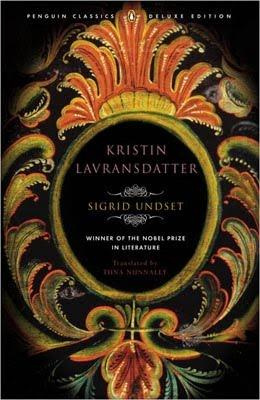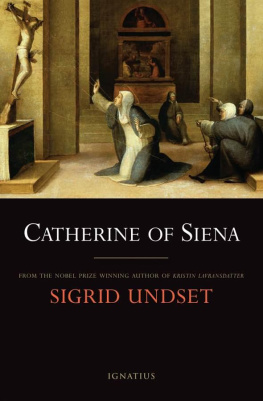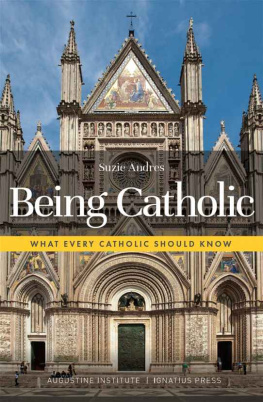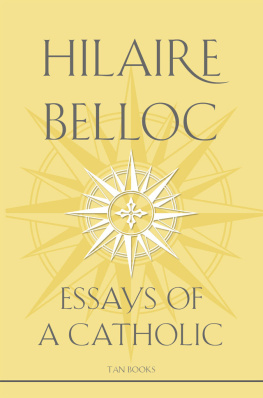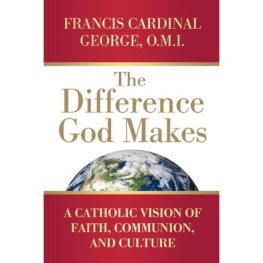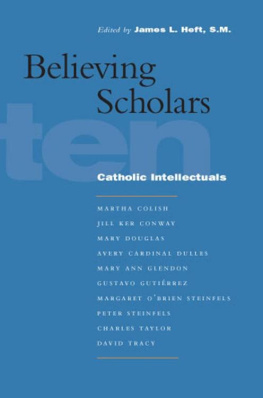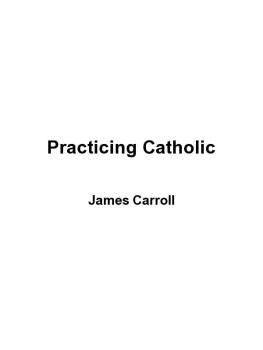Undset always had a keen appreciation for the spiritual drama within what may be described, from the outside, as the ordinary life. This is reflected in her Saga of Saints , a history of those saints who had helped shape Christianity in Norway, in which she permits holiness to shine through without denying or obscuring the struggles and difficulties of the Church. It is also evident in her book Stages on the Road , a collection of essays on Ramon Lull, Angela Merici, Robert Southwell and Margaret Clitherow.... We are fortunate that so much of her work was rapidly translated into English and widely circulated in that language.... For Undset the preeminent human drama was also a divine drama: on one side is the Fathers initiation of redemption and the Sons entrance into history; on the other is each persons attachment to the wrong things, an ineffable yearning for the freedom of the children of God, and a little-understood yet still-desperate thirst for grace. This drama works itself out in uncounted ways, an often discordant composition of both the gold and the dross of daily life, resonating at every level of being, and alteringfor good or illeverything we touch. In Undset we find the consummate Catholic author, seeing life both steadily and whole, and unveiling for us its deep and ultimate meaning as we read.
Jeffrey A. Mirus
President
Trinity Communications
Through six long-form essays, Sigrid Undsets sprightly prose gallops so nimbly one forgets one is reading biography and surrenders to these stories as to the most compelling fictiontraveling through error and ego with Ramon Lull of Palma and sharing Angela of Mericis itchy sense of discontent and mission. We compare present challenges to the faith against the underground maneuverings of Robert Southwell and Margaret Clitherow and find both instruction and perspective in their placidity, even as we revel at the terrible romance of their martyrdoms. First published in English in 1934, Undsets Stages on the Road remains a thumping good read that has something to say to the era, and more than validates her reemergence in the twenty-first century as an energetic, passionate voiceone that urges the faithful onward, and onward still, through brambles of history and passing modern trends, toward a Truth that is startlingly alive.
Elizabeth Scalia
The Anchoress on Patheos

Translated from the Norwegian by Arthur G. Chater. Originally published in 1934 by Alfred A. Knopf, Inc.
____________________________________
Foreword copyright 2012 by Elizabeth Scalia.
All rights reserved. No part of this book may be used or reproduced in any manner whatsoever except in the case of reprints in the context of reviews, without written permission from Christian Classics, Ave Maria Press, Inc., P.O. Box 428, Notre Dame, IN 46556.
Founded in 1865, Ave Maria Press is a ministry of the United States Province of Holy Cross.
www.christian-classics.com
Paperback: ISBN-10 0-87061-258-1 ISBN-13 978-0-87061-258-9
E-book: ISBN-10 0-87061-270-0 ISBN-13 978-0-87061-270-1
Cover image Helder Joaquim Soares Almeida / SuperFusion / SuperStock .
Cover and text design by Katherine Robinson Coleman.
Printed and bound in the United States of America.
Library of Congress Cataloging-in-Publication Data
Undset, Sigrid, 18821949.
[Etapper (ny rkke). English]
Stages on the road / Sigrid Undset ; [translated from the Norwegian by Arthur G. Chater].
p. cm.
Includes bibliographical references (p. ).
ISBN 978-0-87061-258-9 (pbk.) -- ISBN 0-87061-258-1 (pbk.)
1. Catholics--Biography. 2. Catholic Church--Doctrines. I. Title.
BX4651.3.U5313 2012
282.0922--dc23
[B]
2012006169
CONTENTS

CHAPTER 1
CHAPTER 2
CHAPTER 3
CHAPTER 4
CHAPTER 5
CHAPTER 6
A NOTE ON THE TEXT

This edition of Stages on the Road was set from the 1934 English-language edition of the work published in the United States by Alfred A. Knopf. In addition to Americanizing the spelling and occasionally altering the punctuation in the interest of clarity, the editors have moved the original footnotes to the back of the book.
The contemporary reader should also be aware that several of the figures mentioned in the book have been canonized since the work was first published, including St. Thomas More (1935), St. John Fisher (1935), St. Edmund Campion (1970), St. Robert Southwell (1970), St. Margaret Clitherow (1970), and St. John Ogilvie (1976).
FOREWORD

Nearly a century has passed since Sigrid Undset wrote the essays that would eventually be collected and published under this title, and indeed Stages on the Road is evocative of the life of faith, wholly explored and lived outunpacked depot by depot, as it werefrom the spiritual nursery, to precarious venturing forth, to stepping back in wonder or doubt, to the nearly inevitable and deepening darkness that, for all its pain, accesses an interior cave of Oneness, solitary yet completed in the companionship of Christ. This last stage is something akin to what St. Catherine of Siena referred to as the inner cell or the cell of true self-knowledge. Undset, like Catherine, a Third Order Dominican, shared with that clear-eyed Doctor an impatience with the sort of illusions bred by social conventions and encouraged by trends. Raised by progressively minded atheists, Undset realized while still a teenager that ideologies and their accompanying isms gave inadequate measures of the world and humanity, always narrowing truth precisely at the point where what is required is a broadness of understanding and the oxymoronic-sounding bold nuance of genuinely small-c catholic thinking. Sketching her autobiography for some editors in 1940, Undset wrote, [World War I] and the years afterwards confirmed the doubts I always had about the ideas I was brought up on(I felt) that liberalism, feminism, nationalism, socialism, pacifism, would not work, because they refused to consider human nature as it really is.
Sigrid Undsets life was a heavy one, and it seems if she could not have joy, she was determined to have light. Seeking after the clarity that sees past times and trends to what is eternal and true, and unwilling to live her life in ideological self-containment, it is not surprising that Undset would eventually come to call the Catholic Church home, or that she would credit the saints with delivering her to its doors. Undsets fiction is populated with vividly drawn characterspeople of action whose narratives are built very precisely upon human nature as it really is, including the propensity for doubt and regret. To discover genuine men and women living boldlynot excused from those same propensities, yet mysteriously delivered of them in the promise of a life in and with Christ, must have been for Undset a moment of staggering, irresistible illumination. Undset states:
By degrees my knowledge of history convinced me that the only thoroughly sane people, of our civilization at least, seemed to be those queer men and women the Catholic Church calls Saints. They seemed to know the true explanation of mans undying hunger for happinesshis tragically insufficient love of peace, justice, and goodwill to his fellow men, his everlasting fall from grace. Now it occurred to me that there might possibly be some truth in the original Christianity.... But if you desire to know the truth about anything, you always run the risk of finding it. And in a way we do not want to find the Truthwe prefer to seek and keep our illusions. But I had ventured too near the abode of truth in my researches about Gods friends, as the Saints are called in the Old Norse texts of Catholic times. So I had to submit.
Next page

